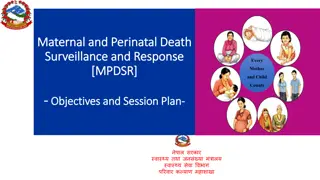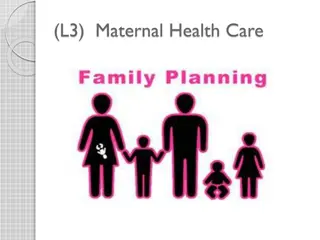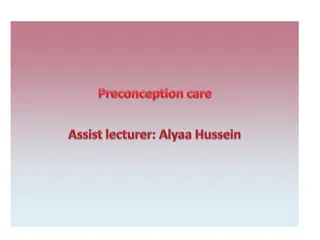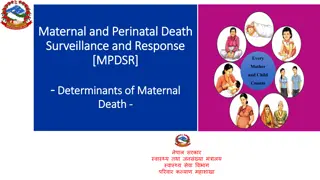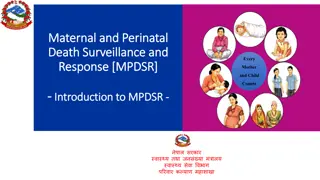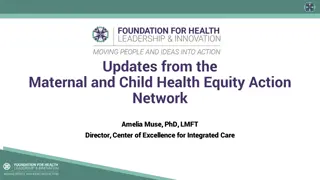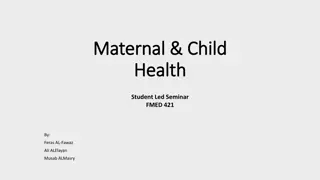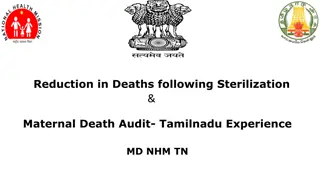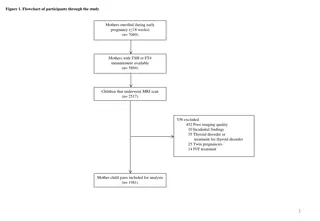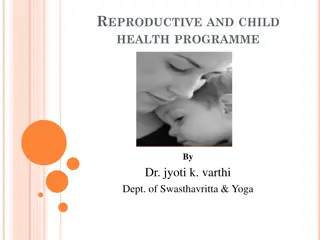Trends in Maternal and Child Health Nursing by Dr. Rabea M. Ali
Dr. Rabea M. Ali discusses the emerging trends in maternity nursing, emphasizing the importance of family-centered care in maternal and child health nursing. The philosophy of this practice involves community-centered care, research orientation, and advocacy for the rights of all family members, including the fetus. Maternal and child health nursing plays a crucial role in promoting wellness and addressing the diverse needs of families, with an emphasis on individual and family assessments, independent teaching, and cultural sensitivity.
Download Presentation

Please find below an Image/Link to download the presentation.
The content on the website is provided AS IS for your information and personal use only. It may not be sold, licensed, or shared on other websites without obtaining consent from the author.If you encounter any issues during the download, it is possible that the publisher has removed the file from their server.
You are allowed to download the files provided on this website for personal or commercial use, subject to the condition that they are used lawfully. All files are the property of their respective owners.
The content on the website is provided AS IS for your information and personal use only. It may not be sold, licensed, or shared on other websites without obtaining consent from the author.
E N D
Presentation Transcript
New trend in maternity nursing prof.Dr. Rabea M. Ali
Philosophy of Maternal and Child Health Nursing Maternal and child health nursing is family centered; assessment data must include a family and individual assessment. Maternal and child health nursing is community centered; the health of families depends on and influences the health of communities. Maternal and child health nursing is research oriented, because research whereby critical knowledge increases. Both nursing theory and evidence-based practice provide a foundation for nursing care is the means
Cont. A maternal and child health nurse serves as an advocate to protect the rights of all family members, including the fetus. Maternal and child health nursing includes a high degree of independent because teaching and frequently required. Promoting health is an important nursing role, because this protects the health of the next generation. Pregnancy or childhood illness can be stressful and can alter family life in both subtle and extensive ways. nursing counseling functions, are so
Cont. Personal, cultural, and religious attitudes and beliefs influence the meaning of illness and its impact on the family. Maternal and child health nursing is a challenging role for a nurse and is a major factor in promoting high-level wellness in families
Common Centered Maternal and Child Health Care Principle Measures to Ensure Family- 1. The family is the basic unit of society. Families represent racial, ethnic, cultural, and diversity. 3. Children grow both individually and as part of a family. 2. socioeconomic
Nursing Interventions Consider the family as a whole as well as its individual members. Encourage families to community so that family members are not isolated from their community or from each other. Encourage family bonding through rooming-in in both maternal and child health hospital settings. Participate in early hospital discharge programs to reunite families as soon as possible. Encourage family and sibling visits in the hospital to promote family contacts. reach out to their
Cont. Assess families for strengths as well as specific needs or challenges. Respect diversity in families as a unique quality of that family. Encourage families to give care to a newborn or ill child. Include developmental stimulation in nursing care. Share or initiate information planning with family members so that care is family oriented. on health
family-centered care and the nursing process American Nurses Association/Society of Pediatric Nurses Standards of Care and Professional Performance Standards of Care Comprehensive pediatric nursing care focuses on helping children and their families and communities achieve their optimum health potentials This is best achieved within the framework of family- centered care and the nursing process, including primary, secondary, and tertiary care coordinated across health care and community settings.
Standard I: Assessment The pediatric nurse collects patient health data. Standard II: Diagnosis The pediatric nurse analyzes the assessment data in determining diagnoses. Standard III: Outcome Identification The pediatric nurse identifies expected outcomes individualized to the child and the family. Standard IV: Planning The pediatric nurse develops a plan of care that prescribes interventions to obtain expected outcomes. Standard V: Implementation implements the interventions identified in the plan of care. Standard VI: Evaluation The pediatric nurse evaluates the child s and family s progress outcomes. The pediatric nurse toward attainment of
Association of Womens Health, Obstetric, and Neonatal Nurses Standards and Guidelines Standards of Professional Performance Standard I: Quality of Care The nurse systematically evaluates the quality and practice. Standard II: Performance Appraisal The nurse evaluates his/her own nursing practice in relation to professional practice standards and relevant statutes and regulations. Standard III: Education The nurse acquires and maintains current knowledge in nursing practice. Standard IV: Collegiality The nurse contributes to the professional development others. Standard V: Ethics The nurse s decisions and actions on behalf of patients are determined in an ethical manner. effectiveness of nursing of peers, colleagues, and
Standard VI: Collaboration The nurse collaborates with the patient, significant others, and health care providers in providing patient care. Standard VII: Research The nurse uses research findings in practice. Standard VIII: Resource Utilization The nurse considers factors related to safety, effectiveness, and cost in planning and delivering patient care. Standard IX: Practice contributes to the environment of care delivery within the practice settings. Standard X: Accountability The nurse is professionally and legally accountable professional registered nurse may delegate to and supervise qualified personnel who provide patient care. Environment The nurse for his/her practice. The
Trend In the changing scenario of health care system of today s world, the trends in maternal and newborn health nursing are also changing.(Radhika,2016) New Trends in Maternity's & Midwifery Nursing is rapidly changing the professionals to remain up-to-date in order to react to new any developments as they occur world, that required
Technological Advances Today fetal monitoring has progressed from the use of Feto-scope to electronic fetal monitor such as: 1. Bella beat Shell 2. Bloom life
Bella beat's Shell : app It works to amplify the sound of baby's heartbeat when pressed to the mother's body, as well as to let to record the audio and even share it with friends and family via the app. to regular appointments.
Bloom life woman not supposed to wear it the whole time but for one, two or three months of third trimester. It sticks onto the belly and measures the count and timing of contractions (both Braxton Hicks and labor) via electrical signals from the uterine muscle.
Noninvasive prenatal testing or NIPT (2000s) a blood test, can be done as early as the 9th week of pregnancy and can screen for chromosomal abnormalities in baby. Unlike amniocentesis, NIPT carries no risk of miscarriage. Early diagnosis of chromosomal disorders, including microdeletions ensures that affected babies receive the care they need as soon as possible.
Cell-free DNA genetic screening Cell-free DNA screening is the newest way to screen for genetic problems in the baby. This is a simple blood test that can detect pieces of the baby's DNA in mom's blood to determine if there may be a problem with the pregnancy.
Clearblue Digital pregnancy test. Description Unmistakably clear results Over 99% accurate Results 5 days sooner The pregnancy and Clearblue Digital can be used to test up to 4 days before the expect period (5 days sooner than missed period). **99% accurate at detecting typical pregnancy hormone levels. pregnancy hormone increases rapidly in early
tests can be used either in-stream simply by holding the tip directly in the urine stream for 5 seconds; or by dipping the test into a collected urine sample for between 5 - 20 seconds, depending on the product used. Keep in mind you should always read the instruction leaflet before testing
Trends in Maternal and Child Health Care and Implications for Nurses Trend Families are smaller than in previous decades. Implications for Nursing Fewer family members are present as support in a time of crisis. Nurses must fulfill this role more than ever before. Single parents are increasing in number A single parent may have fewer financial resources; this is more likely if the parent is a woman. Families are more mobile than Good interviewing is necessary with previously; there is an increase in mobile families so a health database the number of homeless women can be established; education for and children. health monitoring is important.
Abuse is more common than Screening for child or intimate ever before partner abuse should be included in family contacts. Be aware of the legal responsibilities for reporting abuse. Families are more health- Families are ripe for health conscious than previously. education; providing this can be a major nursing role.` Health care must respect cost containment Comprehensive care is necessary in primary care settings because referral to specialists may no longer be an option



